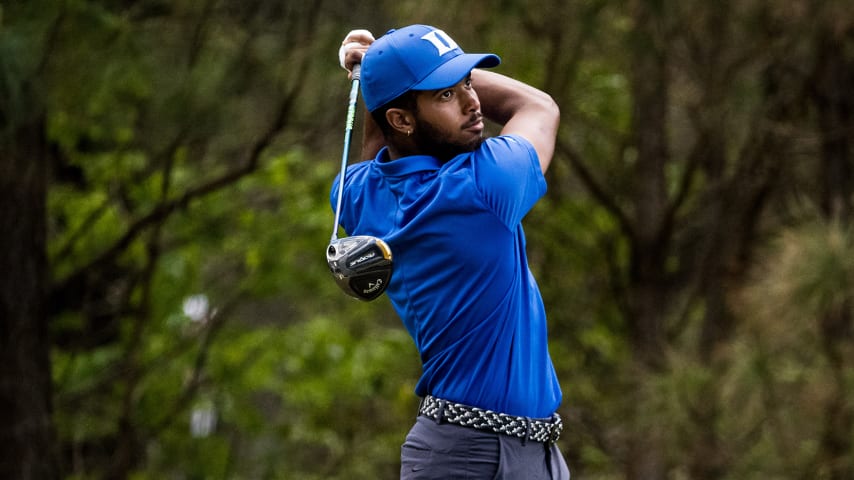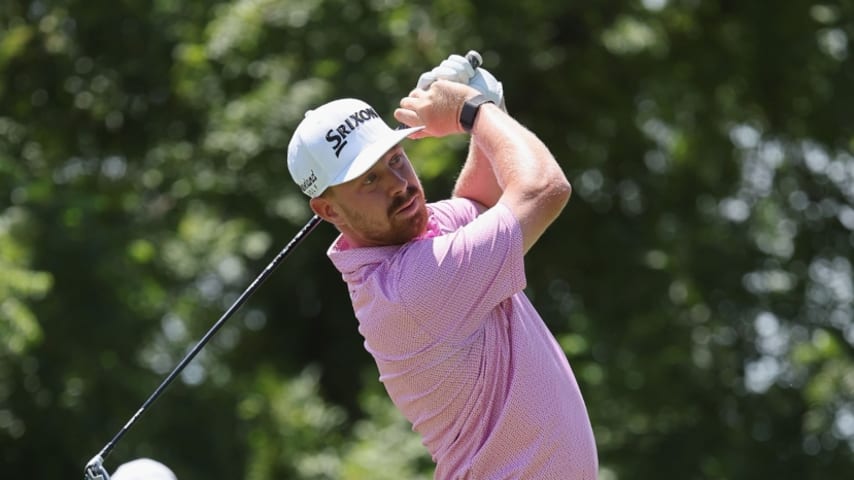How adaptive golf champion Jake Olson finds beauty in the game
7 Min Read

Written by Helen Ross

Blind golfer Jake Olson meets Chesson Hadley at Genesis
Jake Olson was eight months old when doctors told his parents he had bilateral retinoblastoma, and they would need to remove his left eye.
For the next 12 years, Olson lived as normal a life as possible – playing golf and flag football – in between chemotherapy treatments as the cancer kept attacking his right eye.
At first, the chemo was introduced into his bloodstream and left him “sick as a dog,” Olson recalls. “It was pretty much poisoning your body to death, and you hoped that the cancer died before your body did.”
Around the time he was 10, doctors started using a new targeted therapy called intra-arterial chemo where the drug was administered through a catheter in his femoral artery that snaked up to his ophthalmic artery and eye. Olson was one of a handful of young patients getting the treatment and it was not without risks.
“Kids were going through a lot of different consequences of this because you're going through your femoral artery, you're going through all these different arteries,” Olson says. “Like you block one of those for a split second, your brain is losing oxygen quickly.”
When the cancer returned for the eighth time, Olson’s doctors knew they had exhausted all options. Curing the cancer wasn’t possible, and the possibility of it spreading to his brain and the rest of his body was just too great. It was time to remove the other eye and save his life.
“It was beyond frustrating in the sense that we had put so much time and effort and hope into beating this cancer … and this thing just wouldn't stay away,” Olson says. “… We literally just did everything we could and for it just to eventually take my eyesight, it was demoralizing. …
“And then just obviously the reality of what you were confronting, realizing you’re 12 and you have the most probably formative years of your life in the next 10 to 15 years with going to high school and college and all that, and to kind of go through that while just the most massive change you could probably think of was very uncertain and scary to say the least.”
Olson, though, was nothing if not determined. Instead of feeling sorry for himself, the seventh grader set about learning how to read braille and how to eat and brush his teeth and use a cane. “Literally, life 101 was, was being taught to me at 12 again,” he says. “… You'd be surprised how quickly you can learn when you're absolutely forced to.”
Olson started playing golf – a game he began playing with his dad and had started to take seriously in the year before he went blind – again, too. Returning to some sense of normalcy was important.
“We didn't want to live in this reality and world that blindness absolutely just uprooted everything, and we couldn't enjoy things we wanted to do,” Olson explains.
Olson not only was able to have fun playing golf again, he became good at it. Now 25 years old and the 2019 United States Blind Golf Association champion, Olson is competing in the inaugural U.S. Adaptive Open this week at Pinehurst No. 6.
There are 96 players, including five-time PGA TOUR winner Ken Green, who lost his right leg in an RV accident, and Amy Bockerstette, who has Down syndrome, in the field. The impairment categories are arm, leg, multiple limb amputee, vision, intellectual and neurological, as well as seated players and those of short stature. Olson is the only completely blind golfer in the field.
“I knew was it was going to be an honor if I had the chance of playing in it,” says Olson, who has a 10 handicap. “… And from a, from a USGA standpoint, I commend them for just realizing that here are these golfers who really could be argued as some of the best golfers in the world, given that they're playing at a level while having some type of disability or some type of real challenge with playing this game normally and to go out there and play the way they do.
“I think that should absolutely be highlighted and rewarded, so I'm glad they are doing that.”
Olson has also made his mark on the football field. He talked with friends on his high school team to see if there was a way he could contribute. He didn’t want to “sugar coat” things and catch a pass just to say he did it. He wanted to participate, and they came up with making him the long snapper.
So, the summer after his sophomore year in high school, Olson worked hard on perfecting the position. He started as a junior and senior and one day at when he was at a football practice at. Southern Cal, Olson got to talk with the Trojan’s head coach, Steve Sarkisian.
“He's like, well, would you ever want to snap on the team?” Olson recalls. “And I said, would I?”
So, Olson walked on at USC, which he called an “incredible journey,” one that began when former head coach Pete Carroll, now with the Seattle Seahawks, invited him to a practice shortly before he lost his sight. When he snapped for an extra point against Western Michigan in 2017, Olson became the first blind player to compete in college.
And oddly enough, it was football – not golf – that brought Olson and the legendary Tiger Woods together. The former world No. 1 sent him a hand-written letter after he played in his first game for USC.
“He said he saw me and how inspired he was and commended my courage, just my resilience,” Olson says. “He was poking fun a little bit at the fact that he's obviously a (Stanford) Cardinal fan and it's hard to root for the Trojans, but he just was very impressed with just the courage it took to go out there.
“He was impressed with my ability to overcome adversity. And I think he's obviously has quite the appreciation for that in his own career.”
The letter led to several face-to-face meetings at the Genesis Invitational that Woods hosts at Riviera Country Club, which is about an hour from Huntington Beach, California where Olson lives and supervises a gym geared toward players with physical challenges. He also works as a motivational speaker.
Woods is also enamored with Olson’s service dog, a yellow Labrador named Quebec.
“He loves, loves, loves dogs and he loves Quebec,” Olson says with a laugh. “I mean, that's probably one of the reasons why he remembers me.”
Learning to play golf again was a challenge for Olson. He had a hard time connecting with the ball at first, so his teacher had him hit into a bag stuffed with towels to get used to the feel. His father, Brian, is his primary caddy and coach, lining up the shot and giving Olson the lay of the land – all the things most golfers take for granted.
Olson doesn’t remember the first time he completed 18 holes or the first hole he parred as a blind man. But he does remember the satisfaction he got as he gradually got better -- “It was the proverbial two steps forward and one step back, except it was like a hundred steps forward and then 99 steps back, it felt like,” he says.
While Olson admits there may have been a “level of crazy” in his determination to master the game again, he loves playing golf. He can’t see the course anymore, but he appreciates the variety of the holes his father helps him visualize and the shots he needs to hit.
“So, it is really a unique game in the sense that you could play the same course your entire life and probably never, ever, ever have the same round,’ Olson says. “I think that's pretty cool. And then, honestly just the, the challenge is appealing.
“It really is you're battling against yourself; you're battling against your mind and everything that kind of goes into it. And it really is a challenge like none other and I think that that really goes far in life if you can kind of up master some of those intangibles that require you to get good at golf and can kind of exemplify those in other areas of your life.”




